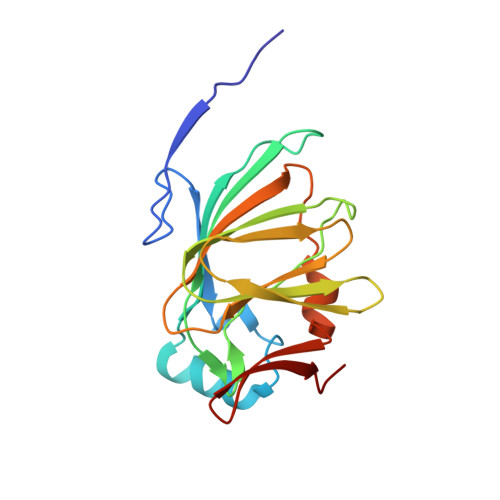Evidence Supporting a cis-enediol-based Mechanism for Pyrococcus furiosus Phosphoglucose Isomerase
Berrisford, J.M., Hounslow, A.M., Akerboom, J., Hagen, W.R., Brouns, S.J., van der Oost, J., Murray, I.A., Michael Blackburn, G., Waltho, J.P., Rice, D.W., Baker, P.J.(2006) J Mol Biol 358: 1353-1366
- PubMed: 16580686
- DOI: https://doi.org/10.1016/j.jmb.2006.03.015
- Primary Citation of Related Structures:
2GC0, 2GC1, 2GC2, 2GC3 - PubMed Abstract:
The enzymatic aldose ketose isomerisation of glucose and fructose sugars involves the transfer of a hydrogen between their C1 and C2 carbon atoms and, in principle, can proceed through either a direct hydride shift or via a cis-enediol intermediate. Pyrococcus furiosus phosphoglucose isomerase (PfPGI), an archaeal metalloenzyme, which catalyses the interconversion of glucose 6-phosphate and fructose 6-phosphate, has been suggested to operate via a hydride shift mechanism. In contrast, the structurally distinct PGIs of eukaryotic or bacterial origin are thought to catalyse isomerisation via a cis-enediol intermediate. We have shown by NMR that hydrogen exchange between substrate and solvent occurs during the reaction catalysed by PfPGI eliminating the possibility of a hydride-shift-based mechanism. In addition, kinetic measurements on this enzyme have shown that 5-phospho-d-arabinonohydroxamate, a stable analogue of the putative cis-enediol intermediate, is the most potent inhibitor of the enzyme yet discovered. Furthermore, determination and analysis of crystal structures of PfPGI with bound zinc and the substrate F6P, and with a number of competitive inhibitors, and EPR analysis of the coordination of the metal ion within PfPGI, have suggested that a cis-enediol intermediate-based mechanism is used by PfPGI with Glu97 acting as the catalytic base responsible for isomerisation.
Organizational Affiliation:
The Krebs Institute for Biomolecular Research, Department of Molecular Biology and Biotechnology, University of Sheffield, Firth Court, Western Bank, Sheffield S10 2TN, UK.
















